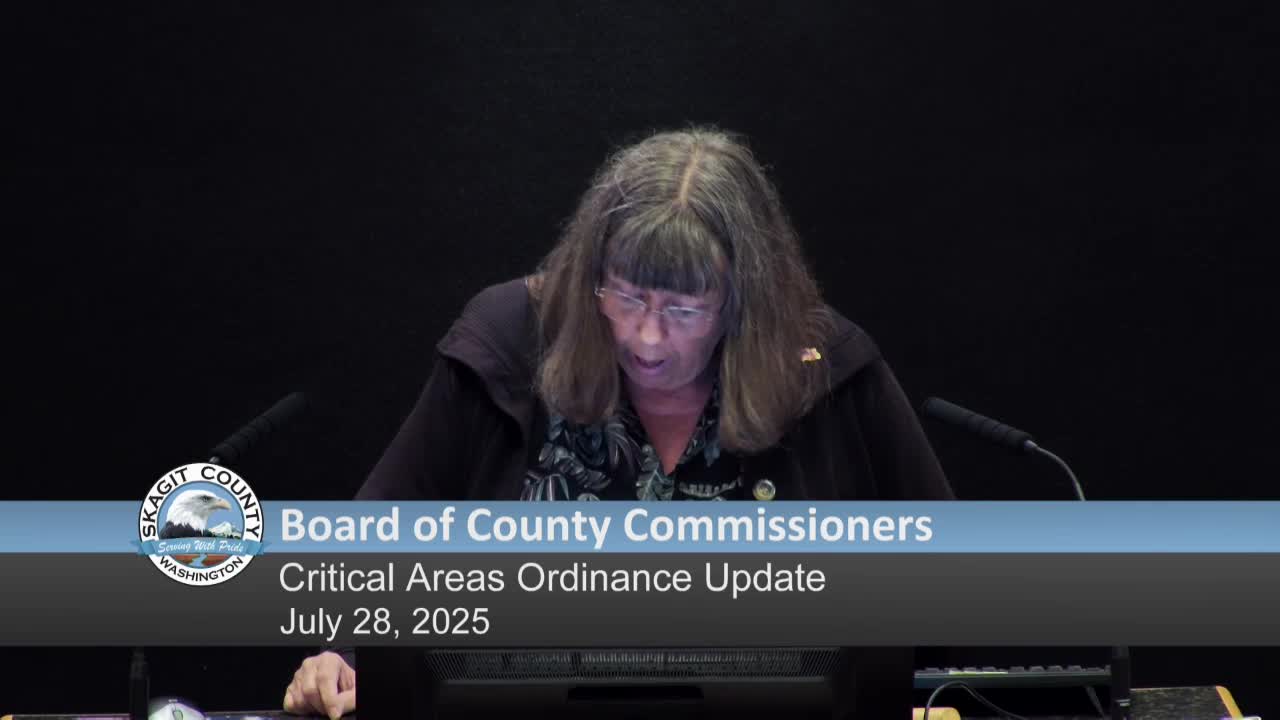Residents Call for Expanded Buffers to Protect Big Lake from Development Pollution
July 28, 2025 | Skagit County, Washington
This article was created by AI summarizing key points discussed. AI makes mistakes, so for full details and context, please refer to the video of the full meeting. Please report any errors so we can fix them. Report an error »

Skagit County officials are facing mounting pressure to revise critical area regulations following a series of public comments highlighting concerns over environmental protections amid ongoing development. During the recent government meeting on July 28, 2025, residents voiced their frustrations regarding the current 200-foot buffer zone that determines the impact of new developments on critical areas, particularly around Big Lake.
Community members, including long-time residents and environmental advocates, argued that the 200-foot distance is insufficient for safeguarding vital ecosystems. They emphasized that critical areas are interconnected with their surrounding environments, and a more comprehensive approach is necessary to mitigate the effects of stormwater runoff and pollution from new developments.
Tammy Grobschmit, a Big Lake resident and advisory committee member, pointed out that increased development has led to heightened pollution levels in the lake. She urged county officials to expand the buffer zone beyond the current limit to encompass the entire watershed, thereby enhancing protections against harmful runoff. Grobschmit's comments were echoed by others, including Jan Edelstein, who stressed that the existing regulations do not align with the best available science regarding stormwater management.
Edelstein highlighted that stormwater runoff often bypasses the 200-foot buffer, allowing pollutants to flow directly into Big Lake. She called for off-site impact analyses for developments that discharge stormwater, arguing that the current regulations fail to adequately protect the lake's water quality.
Jake Hoopmans, representing his parents who live in Big Lake, shared alarming evidence of pollution from a recently approved project that did not undergo a critical areas assessment. He presented data showing spikes in phosphorus levels in the lake, linking them to stormwater runoff from impervious surfaces created by new developments.
The discussions at the meeting underscored a growing concern among residents about the potential long-term impacts of climate change and increased development on local ecosystems. As the county prepares to review its critical area regulations, community members are advocating for stronger protections to ensure the health of their environment and the sustainability of their water resources.
The county's next steps will be crucial in determining how effectively it can balance development needs with environmental stewardship, as residents continue to call for action to safeguard their critical areas against future climate challenges.
Community members, including long-time residents and environmental advocates, argued that the 200-foot distance is insufficient for safeguarding vital ecosystems. They emphasized that critical areas are interconnected with their surrounding environments, and a more comprehensive approach is necessary to mitigate the effects of stormwater runoff and pollution from new developments.
Tammy Grobschmit, a Big Lake resident and advisory committee member, pointed out that increased development has led to heightened pollution levels in the lake. She urged county officials to expand the buffer zone beyond the current limit to encompass the entire watershed, thereby enhancing protections against harmful runoff. Grobschmit's comments were echoed by others, including Jan Edelstein, who stressed that the existing regulations do not align with the best available science regarding stormwater management.
Edelstein highlighted that stormwater runoff often bypasses the 200-foot buffer, allowing pollutants to flow directly into Big Lake. She called for off-site impact analyses for developments that discharge stormwater, arguing that the current regulations fail to adequately protect the lake's water quality.
Jake Hoopmans, representing his parents who live in Big Lake, shared alarming evidence of pollution from a recently approved project that did not undergo a critical areas assessment. He presented data showing spikes in phosphorus levels in the lake, linking them to stormwater runoff from impervious surfaces created by new developments.
The discussions at the meeting underscored a growing concern among residents about the potential long-term impacts of climate change and increased development on local ecosystems. As the county prepares to review its critical area regulations, community members are advocating for stronger protections to ensure the health of their environment and the sustainability of their water resources.
The county's next steps will be crucial in determining how effectively it can balance development needs with environmental stewardship, as residents continue to call for action to safeguard their critical areas against future climate challenges.
View full meeting
This article is based on a recent meeting—watch the full video and explore the complete transcript for deeper insights into the discussion.
View full meeting
